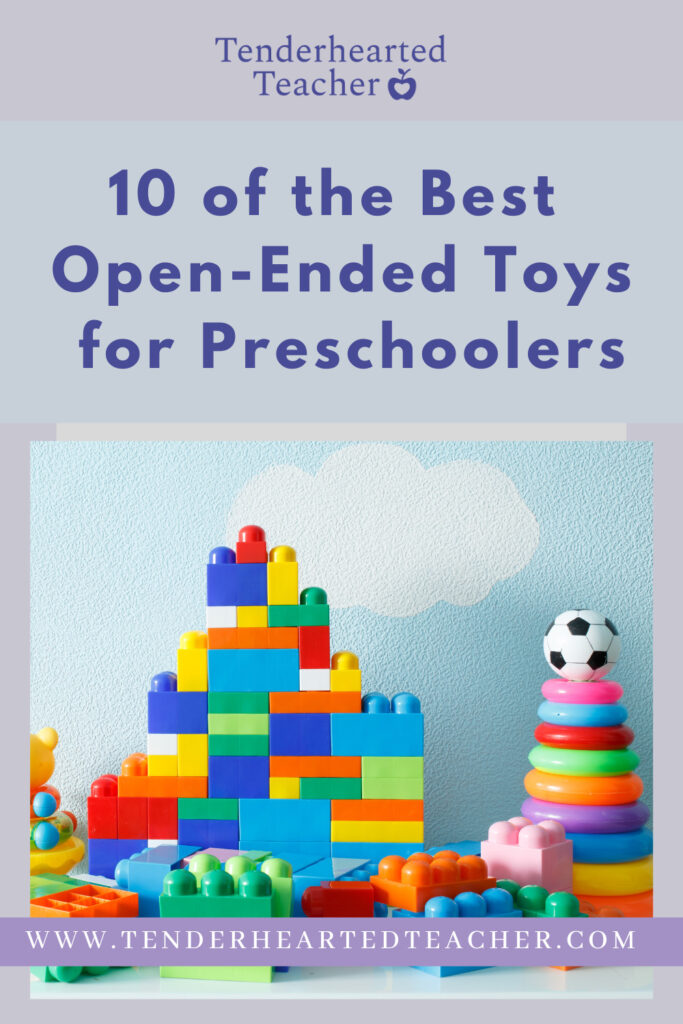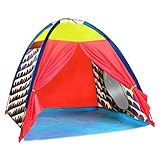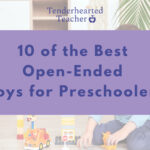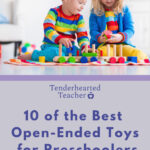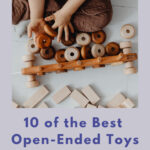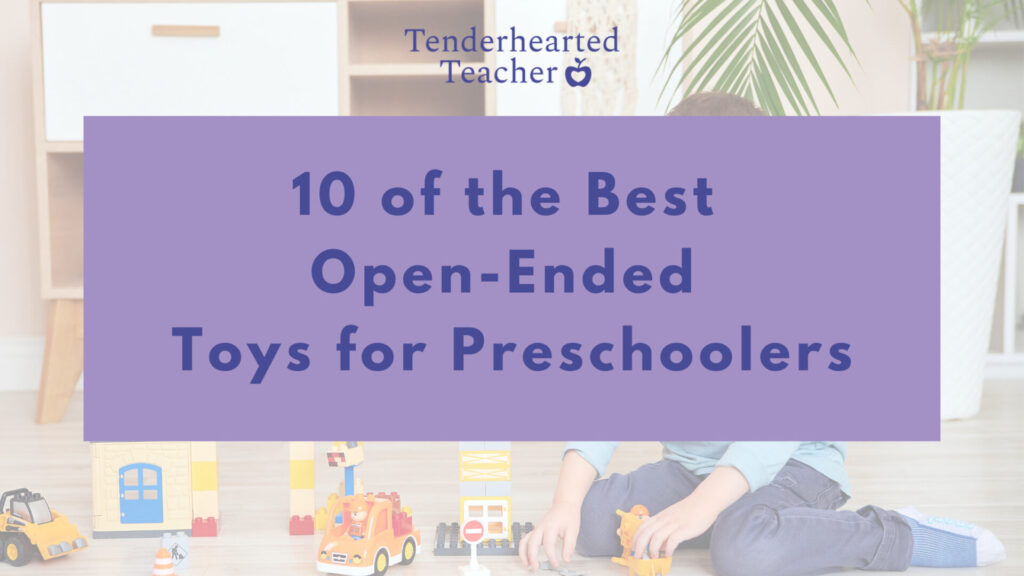
We’ve talked countless times about the importance of play in early childhood, stages of play development, and various types of play that benefit our young children. Today, I’d like to discuss the power of open-ended play, specifically. In this blog post, I’ll define what it is, why it’s great for our little ones, how to encourage this type of play at home, and I’ll also list 10 of the best open-ended toys for preschoolers! Read more below!
Please note: This post may contain affiliate links. As an Amazon Associate, I earn from qualifying purchases. Therefore, if you buy something through these links I will receive a small commission at no extra cost to you. Thank you for your support.
What is Open-Ended Play?
Open-ended play refers to a type of unstructured play where children explore materials without specific rules or predetermined outcomes. This differs from structured play (i.e. board games, organized sports, etc.) in which children have to follow certain directions or use toys with a fixed purpose. Examples of open-ended play for preschoolers include building with blocks, creating with play dough, engaging in pretend play with dolls or action figures, drawing and painting, and exploring the outdoors.
Benefits of Open-Ended Play
“When children choose how to play for themselves, they experience freedom in making those choices. They also begin to see connections between choice and the consequences or results of that choice. The type of toys or materials parents offer can help their children make more meaningful decisions. Open-ended materials can be used in many ways so children can decide for themselves how to use them.”
Marcia L. Nell and Walter F. Drew (NAEYC)
During this type of exploration, children use their imaginations and creativity to come up with their own play scenarios and characters as well as to use materials in their own ways. This encourages problem-solving, experimentation, and self-expression. This type of play also tends to engage children for longer periods of time because they are not limited to a set of predetermined outcomes or rules. In addition to enhancing creativity and imagination, open-ended play offers numerous benefits that relate to a child’s cognitive, social-emotional, language, and physical development. Here are some of these benefits:
Problem-Solving & Creativity & Self-Confidence
When engaged in open-ended play, children may encounter challenges that require them to think critically and find solutions independently. This enhances their problem-solving abilities, cognitive flexibility, and creativity as well as helps build resilience and frustration tolerance.
Social-Emotional & Language Development
Open-ended play, which engages multiple children, helps foster social-emotional skills such as cooperation, negotiation, sharing, and empathy. It also promotes inclusivity because it allows children of all different ages, backgrounds, and abilities to play together. Additionally, children hone their language and communication skills as they engage in storytelling and role-playing together.
Self-Regulation & Focus
In open-ended play, children have the freedom to explore at their own pace as well as make independent choices. This helps them to self-regulate and develop self-control. As previously mentioned, children also tend to become deeply engrossed in open-ended play. This, in turn, develops their ability to focus and concentrate on tasks for extended periods of time.
Fine & Gross Motor Skills
Activities like building with blocks, manipulating small toys or objects, and drawing with various writing utensils strengthen fine motor skills and hand-eye coordination. Outdoor play and exploration, such as climbing, running, and jumping, improve gross motor skills as well.
How to Encourage Open-Ended Play in Young Children
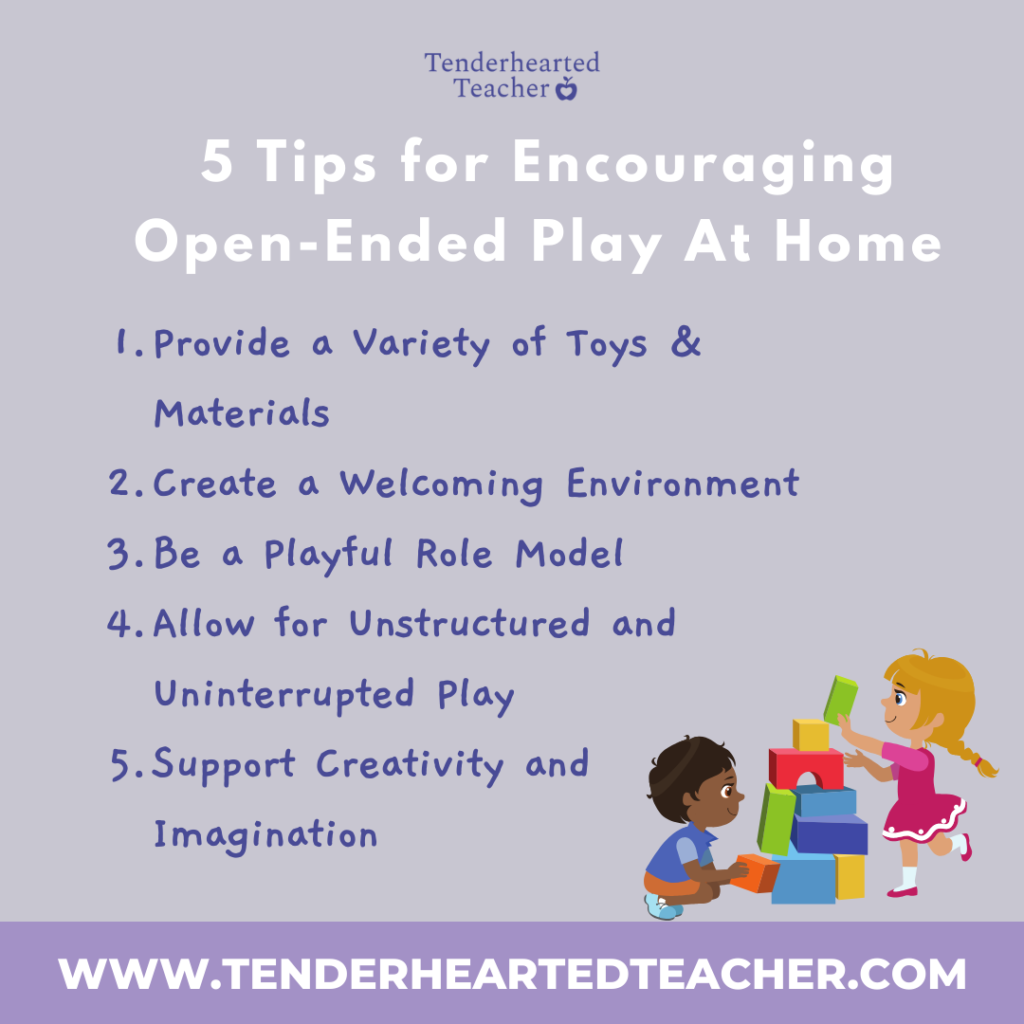
Now that you know why open-ended play is beneficial, I’d like to share five tips on what you can do at home to encourage this type of play with your little one.
1. Provide a Variety of Toys & Materials
Offer a diverse selection of toys and materials such as building blocks, play dough, art supplies, dress-up clothing, and even natural materials such as sticks and leaves. Having an array of options can spark different interests and play scenarios. In addition, it’s important to rotate these items, periodically, to keep the play environment fresh and exciting. Finally, minimize screen time and electronic devices and promote hands-on activities that engage the senses instead.
2. Create a Welcoming Environment
Set up a play space that is conducive to open-ended play. Organize toys in a way that allows children easy access to materials and encourages them to explore and use them independently. If possible, create open spaces where children can move around freely and engage in large-scale play activities. If you can’t do this in your indoor space, get outside and encourage outdoor exploration.
3. Be a Playful Role Model
Show your child how to engage in open-ended play by joining in and playing alongside them. Demonstrate creativity and enthusiasm during playtime. Additionally, encourage collaborative play with siblings or friends because interacting with others can inspire new ideas and cooperation.
4. Allow for Unstructured and Uninterrupted Play
Ensure there is ample time for unstructured and uninterrupted play–where children can freely explore and create without specific goals or time constraints. Avoid imposing rigid rules or solutions during this type of play so that children can become fully immersed without distractions.
5. Support Creativity & Imagination
Don’t immediately intervene every time your child runs into a problem. Allow them to use “out of the box” thinking to come up with their own solutions, creations, and play scenarios. Furthermore, ask them open-ended questions that prompt imaginative thinking such as “What do you think would happen if you…?” or “What kind of story are you creating here?”
10 of the Best Open-Ended Toys for Preschoolers
Not all toys are created equally. Electronic toys can absolutely be fun and flashy, but they are limited in their purpose and tend to lose their novelty pretty quickly. That’s why I suggest spending your well-earned money on toys with more than one function. Mind you, if you don’t want to break the bank you can always turn common household items such empty boxes, cups, bowls, containers, etc., into open-ended play materials too.
But, if you’re looking for some great gift ideas for your little one, here’s a list of 10 of my favorite store-bought toys that can encourage creativity, imagination, and problem-solving skills. (Note, if I could not find exact matches for those I use in my classroom and/or home, I’ve suggested similar highly-rated products from Amazon.)
1. Wooden Blocks
Wooden blocks tend to be on the pricier side, but consider them an investment because they are extremely durable and can be used to create countless play scenarios for years to come! Check out how you can use blocks to encourage your child’s early math skills too.
- 60 natural finished, smooth-sanded hardwood blocks to inspire hands-on, imaginative play
- Packaged in a handsome, wooden tray for easy storage
- Ideal for introducing early math concepts, including shapes, parts-to-whole, and sorting
- Exceptional quality and value
- Makes a great gift for 2- to 8-year-olds, for hands-on, screen-free play
2. LEGO DUPLO Blocks
LEGO DUPLO blocks are a fantastic precursor to the traditional connecting blocks we all know and love. These are specifically meant for younger children due to their larger size. Most importantly, they don’t pose a choking hazard.
- Creative Development - Motivate young minds with this toddler-friendly assortment of LEGO DUPLO bricks and pieces. With endless hands-on creative possibilities, the developmental benefits are enormous
- Learning Through Play - Fuel imaginations with 85 colorful bricks including fun pieces, such as a window, car, and 1-2-3 number bricks. With such a versatile toy, kids will never stop playing and learning
- Toddler Development - With a modern design for the buildings, people and objects, it’s easy for parents and carers to share toddlers’ precious developmental milestones as they work together to build, create, and imagine
- Combine and Build - The colorful assortment of bricks, pieces, number and people are conveniently stored in a green storage box with a LEGO DUPLO style 8-stud lid. Combine with other DUPLO sets for even more fun
- Perfect Gift - With colorful bricks and pieces that are easy for small hands to pick up and place, this educational toddlers toy makes a great Christmas or birthday gift for toddlers aged 18+ months
3. Magnetic Tiles
When I tell you magnetic tiles are selected as my students’ favorite classroom toy every year, I’m not exaggerating! These well-made tiles can build endless structures, encouraging a child’s spatial awareness and fine motor skills while fostering imaginative play.
- DREAM BIG & BUILD BIG - No limitations, scalable to build as big as desired by adding more pieces to create the master piece. PicassoTiles in colossal styles.
- LEARNING BY PLAYING - Never too early to start developing kids creativity. Children can acquire strong sense of color, geometrical shapes including 3D forms numbers counts, magnetic polarities & architectural design at early age.
- BONDING BY PLAYING - Entertaining for single or multiple parties and feel the sense of achievement together. Suitable for all ages (3+ and up) by one party of in groups a great way to spend quality time with the family and love ones.
- LEARNING IS FUN - Encourage creativity which is the key factor to success in today's ever-changing environments. Fun and entertaining, perfect educational presents for school age children that will never go out of style.
- CREATIVITY BEYOND IMAGINATION - Magnet Building Tiles Clear 3D color Magnetic Building Blocks Playboards for preschool, pretend play and more. Easy to construct and easy to put away for storage.
4. Play Dough
Play dough is an absolute classic and for good reason! It’s a versatile open-ended toy that encourages sensory exploration and fine motor development. Children can sculpt, mold, and create their own imaginative worlds, as they enhance their artistic abilities.
- CREATIVITY PLUS CONVENIENCE: Play-Doh toys have made kids activities even easier for the grownups with the Fun Tub
- REUSABLE STORAGE CONTAINER: Keep the Play-Doh tools and colors in one place with the tub and resealable lid
- 12 ANIMAL AND SHAPE CUTTERS: Make 3 classic shapes and 9 fun animals like dogs, cats, fish, alligators, and more
- 7 CLASSIC PLAY-DOH ACCESSORIES: Customize the creations with 3 pretend fruit stampers, extruder with rail, roller, and knife
- INCLUDES 5 PLAY-DOH COLORS: 2-ounce cans of blue, orange, teal, purple, and red are perfect for kids arts and crafts time
5. Marble Run
Marble runs are great for teaching cause-and-effect relationships, problem-solving, critical thinking, and engineering skills. Children can spend hours designing intricate tracks, experimenting with gravity, and watching marbles race through their custom-built courses.
- Premium marble run set with transparent parts, endless fun for your child to watch marbles run along tracks
- Premium quality set!
- All tracks are easy to stick together and the set is stable once build up with our professional designed molds
- This STEM marble run set comes with an assembly instruction to help kids’ hand-eye coordination. After they learned, they will have ability to build any different tracks by their imagination and logical mind. Perfect Toy Set to develop kids’ creativity, logical thinking, hand-eye coordination. Play and Gain patient and problem-solving ability. Excellent Gifts for all kids
- CHILD SAFETY: Meet US Safety Standard, Safety Test Approved, 100% Non-Toxic
6. Dramatic Play Kitchen
Play kitchens are wonderful open-ended toys that promote role-playing, social skills, and imaginative play. All playrooms should have one of these so that children can cook, serve, and explore various scenarios, enhancing their creativity and understanding of the world around them. Plus, your child may develop a passion for cooking in real-life too!
- Easy to assemble white marble-colored wooden modern play kitchen--roomy enough for multiple kids to play at once
- Includes oven, stove, microwave, sink, refrigerator with working ice dispenser, freezer, ample storage space for easy cleanup
- Innovative ice maker dispenses two included "ice cubes," dials turn, microwave plate spins, grocery check list, movable hooks, doors open and close
- Perfect for kitchen accessory play sets, pretend food collections, and play pantry products
- Ages 3+; 43.25" x 39" x 15.5" assembled; product made with FSC-certified materials that support responsible forestry; applies to new inventory only (FSC C156584)
7. Arts & Crafts Supplies
Arts and crafts supplies, such as markers, paper, and paints, are ripe for inspiring self-expression and creativity. Children can experiment with colors, textures, and shapes all while boosting their fine motor skills and unleashing their artistic potential.
- CRAYOLA CREATE & CARRY ART KIT: Packed with a variety of Crayola art tools, this art set for kids offers endless creative possibilities for kids and adults alike.
- 2-IN-1 COLORING SET: This art set for kids functions as both a storage case and a lap desk, making it easy to organize and use your art supplies anywhere.
- INCLUDES CRAYONS & MARKERS: Features 16 Construction Paper Crayons, 8 Washable Gel-FX Markers, and 8 classic Fine Line Markers for vibrant, versatile coloring.
- COLORED PENCILS & PAPER: Comes with 12 Short Colored Pencils and 30 sheets of Construction Paper, perfect for drawing, coloring, and crafting.
- PORTABLE DRAWING KIT: Compact and lightweight, this case is perfect for on-the-go art projects, travel, and keeping kids entertained during trips.
8. Musical Instruments
Musical instruments are perfect for fostering a lifelong love of music and creativity. They allow children to experiment with sound, rhythm, and melody, helping them develop a deep appreciation for the arts all while honing their motor skills. Check out my post: How Music and Movement Promote Development in Preschoolers to learn more.
- 10-piece musical instrument set to get kids moving, grooving, and feeling the beat
- Expose your mini-musician to different tones, volume, and rhythm
- Various instruments provide a wide range of sounds
- Includes wooden crate for storage; colors and packaging may vary
- Makes a great gift for 3- to 7-year-olds, for hands-on, screen-free play
9. Play tent
Play tents, like this one, provide a private, imaginative space for kids to play, read, or rest. They encourage storytelling, quiet time, and imaginative adventures. I find these are a great place to decompress after a long day as well!
- Play Tent: An indoor and outdoor tent that doubles as a cozy place for kids to play, read, rest, and dream in!
- Simple Setup: This lightweight and portable tent sets up in minutes for hours of fun!
- Easy Clean: The B. Outdoorsy tent features easy-to-clean fabric and a water-resistant floor.
- UV Protection: This roomy play tent comes with built-in UV protection (UPF 50).
- Age: This colorful tent is recommended for toddlers 18 months +
10. Science Kit
Science experiment kits foster curiosity and critical thinking and allow children to explore the wonders of science through hands-on exploration. To learn more about the importance of STEM education in early childhood visit here. Plus grab a copy of my simple sink or float science experiment free printable!
- SUPER VALUE PACK. Amazing Gift Set includes 1x Lab Coat, 1x name badge, 4x large test tubes with stand, 4x eyedropper, 3 size funnels, 5 size measuring spoons, 1 Large measuring cup, 6x small measuring cup, 1x plastic beaker, 1x magnifier, 1x tweezers, 1x safety glasses, 1 stirring rod, 3 color agents, 1 pack citric acid, 1 pack baking soda, 2x balloon, 20x color catcher sheets, 1x double-sided activity cards book.
- STEM LEARNING. The most popular Science set for kids, this set will enhance the love of STEM learning and great for learning science. Great for kid scientists, for dressing up as a scientist and being a scientist for a Costume party and Future Career Day at school.
- ENDLESS FUN. Variety of Science tool toys kit, which is an early hands-on scientific exploration for boy or girl kids scientists ages 3-11. Includes activity cards with step-by-step activities, Kids can easily follow the step-by-step instructions while sharpening skills like problem-solving, sequential thought, and math concepts.
- PREMIUM QUALITY. High-quality washable material Kids science lab coat for dressing up as a scientist. The customizable name badge can make your own scientist badge. Child safe. Meet US toy standard. Safety test approved.
- EXCEPTIONAL CARE: We're big on the little things. That's why customer safety and satisfaction are at the heart of everything we do. Contact us if products don't meet your expectations. We look forward to ensuring every moment brings you joy.
Conclusion
By fostering open-ended play, caregivers can nurture their child’s curiosity, creativity, and joy of exploration, which are vital qualities for lifelong learning and growth.
I hope these open-ended toy suggestions will provide your preschooler with hours of engaging and educational play while fostering their overall development.
Now talk to me! What are your child’s favorite open-ended toys or activities at home? Please share them in the comments below!
SAVE TO PINTEREST
